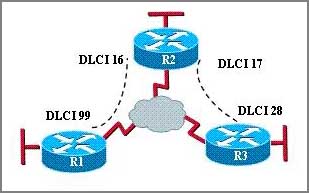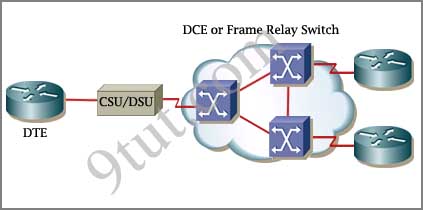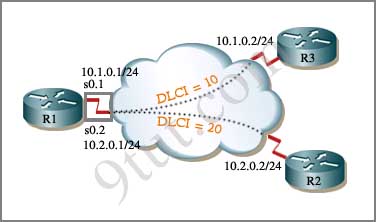CCNA – WAN
Here you will find answers to WAN Questions
If you are not sure about Frame Relay, please read my Frame Relay tutorial.
Question 1
The command frame-relay map ip 10.121.16.8 102 broadcast was entered on the router. Which of the following statements is true concerning this command?
A: This command should be executed from the global configuration mode.
B: The IP address 10.121.16.8 is the local router port used to forward data.
C: 102 is the remote DLCI that will receive the information.
D: This command is required for all Frame Relay configurations.
E: The broadcast option allows packets, such as RIP updates, to be forwarded across the PVC.
Correct Answers: E
Explanation:
The command frame-relay map ip 10.121.16.8 102 broadcast means to mapping the distal IP 10.121.16.8 102 to the local DLCI 102. When the “broadcast” keyword is included, it turns Frame Relay network as a broadcast network, which can forward broadcasts
Question 2
Refer to the exhibit. Which statement describes DLCI 17?

A: DLCI 17 describes the ISDN circuit between R2 and R3.
B: DLCI 17 describes a PVC on R2. It cannot be used on R3 or R1.
C: DLCI 17 is the Layer 2 address used by R2 to describe a PVC to R3.
D: DLCI 17 describes the dial-up circuit from R2 and R3 to the service provider.
Correct Answers: C
Explanation:
DLCI stands for Data Link Connection Identifier. DLCI values are used on Frame Relay interfaces to distinguish between different virtual circuits. DLCIs have local significance because the identifier references the point between the local router and the local Frame Relay switch to which the DLCI is connected.
Question 3
A default Frame Relay WAN is classified as what type of physical network?
A: point-to-point
B: broadcast multi-access
C: nonbroadcast multi-access
D: nonbroadcast multipoint
E: broadcast point-to-multipoint
Correct Answer: C
Explanation:
Non-Broadcast Multi-Access (NBMA) networks are types such as Frame Relay, X.25, and Asynchronous Transfer Mode (ATM). These networks allow for multi-access, but have no broadcast ability like Ethernet
Question 4
Which of the following are key characteristics of PPP? (Choose three.)
A: can be used over analog circuits
B: maps Layer 2 to Layer 3 address
C: encapsulates several routed protocols
D: supports IP only
E: provides error correction
Correct Answers: A C E
Explanation
Below is some more information about PPP:
PPP (Point-to-Point Protocol) allows authentication such as Password Authentication Protocol (PAP) and Challenge Handshake Authentication Protocol (CHAP) and multilink connections (allow several separate physical paths to appear to be one logical path at layer 3) and can be run over asynchronous and synchronous links.
PPP can work with numerous network layer protocols, including Internet Protocol (IP), Novell’s Internetwork Packet Exchange (IPX), NBF and AppleTalk.
PPP only supports error detection, not error correction so answer E should be understood as “provides error detection”. It is a mistake of this question.
Question 5
Which three Layer 2 encapsulation types would be used on a WAN rather than a LAN? (Choose three)
A: HDLC
B: Ethernet
C: Token Ring
D: PPP
E: FDDI
F: Frame Relay
Correct Answer: A D F
Question 6
Refer to the exhibit. What is the meaning of the term dynamic as displayed in the output of the show frame-relay map command shown?

A: The Serial0/0 interface is passing traffic.
B: The DLCI 100 was dynamically allocated by the router
C: The Serial0/0 interface acquired the IP address of 172.16.3.1 from a DHCP server
D: The DLCI 100 will be dynamically changed as required to adapt to changes in the Frame Relay cloud
E: The mapping between DLCI 100 and the end station IP address 172.16.3.1 was learned through Inverse ARP
Correct Answer: E
Explanation
The term dynamic indicates that the DLCI number and the remote router IP address 172.16.3.1 are learned via the Inverse ARP process.
Inverse ARP is a technique by which dynamic mappings are constructed in a network, allowing a device such as a router to locate the logical network address and associate it with a permanent virtual circuit (PVC).
Question 7
Which of the following describes the roles of devices in a WAN? (Choose three.)
A: A CSU/DSU terminates a digital local loop
B: A modem terminates a digital local loop
C: A CSU/DSU terminates an analog local loop
D: A modem terminates an analog local loop
E: A router is commonly considered a DTE device
F: A router is commonly considered a DCE device
Correct Answers: A D E
Explanation
The idea behind a WAN is to be able to connect two DTE networks together through a DCE network. The network’s DCE device (includes CSU/DSU) provides clocking to the DTE-connected interface (the router’s serial interface).

A modem modulates outgoing digital signals from a computer or other digital device to analog signals for a conventional copper twisted pair telephone line and demodulates the incoming analog signal and converts it to a digital signal for the digital device. A CSU/DSU is used between two digital lines -> A & D are correct but B & C are not correct.
For more explanation of answer D, in telephony the local loop (also referred to as a subscriber line) is the physical link or circuit that connects from the demarcation point of the customer premises to the edge of the carrier or telecommunications service provider’s network. Therefore a modem terminates an analog local loop is correct.

Question 8
How should a router that is being used in a Frame Relay network be configured to avoid split horizon issues from preventing routing updates?
A: Configure a separate sub-interface for each PVC with a unique DLCI and subnet assigned to the sub-interface
B: Configure each Frame Relay circuit as a point-to-point line to support multicast and broadcast traffic
C: Configure many sub-interfaces on the same subnet
D: Configure a single sub-interface to establish multiple PVC connections to multiple remote router interfaces
Correct Answer: A
Explanation
Look at the figure below:

In the figure, router R1 has two point-to-point subinterfaces. The s0.1 subinterface connects to router R3 and the s0.2 subinterface connects to router R2. Each subinterface is on a different subnet.
Question 9
What can a network administrator utilize by using PPP Layer 2 encapsulation? (Choose three.)
A: VLAN support
B: compression
C: authentication
D: sliding windows
E: multilink support
F: quality of service
Correct Answers: B C E
Explanation
Same as question 4
Question 10
The Frame Relay network in the diagram is not functioning properly. What is the cause of the problem?

A: The Gallant router has the wrong LMI type configured
B: Inverse ARP is providing the wrong PVC information to the Gallant router
C: The S3 interface of the Steele router has been configured with the frame-relay encapsulation ietf command
D: The frame-relay map statement in the Attalla router for the PVC to Steele is not correct
E: The IP address on the serial interface of the Attalla router is configured incorrectly
Correct Answer: D
Explanation
At Attalla router, we find a deleted status but the next map statement indicates an active status, which if for Gallant. Therefore we can deduce the map statement for the PVC from Attalla to Steele is incorrect. Incorrect DLCI assignments that are configured normally shown up as “deleted” in the frame relay maps.



@9tut.
Not that I am not studying consciously besides your terrific guide 9tut. But I have been asked myself and now you, why do you publish 95% of the questions?. Why don’t you post 100%?. Thanks.
Has some bad luck with ACL2 Simulation and lot many questions from frame Relay .
EIGRP SIM is similar to 9TUT,Switch is also similar.
Need to study more .Next attempt in december 2012.
Respect 9TUT
Hi All.
What are the tips to answer the exam in second attempt,have got 762/1000 in todays attempt.
@k@¥.t€£047
Dont ignore WAN ,lots of questions,
I had missed most of them
Just confim to those who are hesistant and looking for more dumps.
Just passed today with 986/1000. thanks to 9tut for the labs and question. i was tested with with ACL2, VTP (with five questions) and EIRGP, four drag and drop questions. please try to read all the questions in 9tut and practice the labs. thanks.
Guys, please advise me which course i take next and tell me the reason you chose.
I’ll give CCNA exam in first week of November..
please contact me who recently passed CCNA exam or planning to give CCNA exam…
please tell me which dump is good and sims…
er.anita.annu@gmail.com
I HAVE A DOUBT… CAN ANY PASSED ENGINEER PLEASE ANSWER IT ?
IN THE CCNA EXAM, CAN WE SKIP ANY UNKNOWN ANSWER ? OR DO WE HAVE TO ANSWER ALL FROM 1 TO 50 QUESTIONS CONTINUOSLY WITHOUT SKIP ?
THANKS
you have to answer 1 to 50 continuosly.
It has become necessary to configure an existing serial interface to accept a second Frame Relay virtual circuit. Which of the following procedures are required to accomplish this task? (Choose three.)
A. Remove the IP address from the physical interface.
B. Encapsulate the physical interface with multipoint PPP.
C. Create the virtual interfaces with the interface command.
D. Configure each subinterface with its own IP address.
E. Disable split horizon to prevent routing loops between the subinterface networks.
F. Configure static Frame Relay map entries for each subinterface network.
Answer to different dump
BCD
ACD
DEF
Which of the three answer is true?
Which command allows you to verify the encapsulation type (CISCO or IETF) for a frame relay link?
A.
show framerelay map
B.
show framerelay lmi
C.
show inter serial
D.
show framerelay pvc
Correct answer: A
pls..can any one explain
q2 & q7 was in my exam 10-11-2012
plz everyone ,if you have a latest DUMP and .vce software please …send me as soon as possible….thx in advance
ashenafi_tmariam@yahoo.com
hani_2012_rad@yahoo.com
after 4 days my exams
@newbie answer is ACD
@Anyone and Everyone
I need to purchase some lab equipment for my CCNA / CCNP. What would you suggest? how many routers switches, etc. and models. I have about 500$ to work with.
can someone please send me the latest dump?
sc.rpion13@hotmail.com
Which command allows you to verify the encapsulation type (CISCO or IETF) for a frame relay link?
A.
show framerelay map
B.
show framerelay lmi
C.
show inter serial
D.
show framerelay pvc
Correct answer: A
Read http://www.mordor.org/CISCO/DOC_ROOT/univercd/cc/td/doc/cisintwk/itg_v1/itg_fmrl.htm for the answer
Regards
@anonymous @cyrax
Which command allows you to verify the encapsulation type (CISCO or IETF) for a frame relay link?
A. show framerelay map
B.show framerelay lmi
C.show inter serial
D.show framerelay pvc
Answer is B —>because lmi shows the cisco type or ietf….(reference todd lamle IOS commands Study Guide)
@anonymous @cyrax
Which command allows you to verify the encapsulation type (CISCO or IETF) for a frame relay link?
A. show framerelay map
B.show framerelay lmi
C.show inter serial
D.show framerelay pvc
Option A Shows The DLCI number And IP address..
So,
Answer is B —>because lmi shows the cisco type or ietf….(reference todd lamle IOS commands Study Guide)
hi boys ccna is good choose i have done
u can try i have done 08-12-2012
i am from srilanka
iam iraj
Correct ans is B.
show framerelay lmi
@anonymous
show frame relay lmi is correct answer it shows the 3types of management interface..show frame relay map shows only the route for ip address using layer 2 dlci number…
@Anybody
@9tut
Whether can we use tab key to fill the full cmds??
Also can we use shortcut cmds in exam like we use in gns3 or packet tracer??
eg:sh run, sh ip int br, sh ip rout…
thanks.
Which command allows you to verify the encapsulation type (CISCO or IETF) for a frame relay link?
A. show framerelay map
B.show framerelay lmi
C.show inter serial
D.show framerelay pvc
A : Verify FR encapsulation type (CISCO OR IETF)
B: Verify LMI type (CISCO OR ANSI OR Q933A)
so, the correct answer is A
TY 9tut.
Today I have passed the CCNA. (860/825)
50 questions 3 labs (VTP, EIGRP, ACL). 35 from 9tut.
Also thanks a lot Brar and Sekhar (still valid from examcollection)
Ty again 9tut
dear all…
i have a doubt in PPP… like i want configuration of PAP CHAP commands together like if pap fails den chap comes into action…
is there any send username R pswd *** required???
@udita_london:
This command is used to apply CHAP auth. and it it fails it will be replaced by PAP
The Command : ” Router (config-if)#ppp authentication chap pap “
@udita_london:
you should set hostname for each of the two routers connected by ppp
and you should also configure username of R1: (the hostname of R2)
and the username of R2: (the hostname of R1)
and the passward should be the same in both of them
@udita_london:
configuration Commands:(connecting London router with Paris router using CHAP)
in the first router (London):
Hostname London
User name Paris password CCNA
in the second router (Paris):
Hostname Paris
User name London password CCNA
thnx fr the info… bt
like we do in PAP AUTHEntication
in PARIS router
encapsulation PPP
PPP authentication PAP
PPP PAP send username PARIS password CCNA
LIKEWISE.. in PAP CHAP command… is there any requiremnt of USING following command
PPP PAP send username PARIS password CCNA???
@udita_london:
I’m Not sure , but i think there is no requirements except in case of Client and Server ..
take a look here : http://www.shy22.com/upfilpng/qor63787.png
i have doubt on qu 10
first, it’s important to understand what the ppp authentication pap chap command means and how it works.
basically it means : the router will try first pap authentication ,and if it does not have any response from the other router on the other end, it will try chap .
what that command does’t mean is :the router will try CHAP authentication if PAP fail.
the configuration is simple ,there are two steps
1-configure a local database for each router
2- use the ppp authentication pap chap interface subcommande in each router
EXEMPLE
let say we have two router R1 and R2
R1
R1(config)#username R2 password cisco
R1(config-if)#encap ppp
R1(config-if)#ppp authentication pap chap
R2
R2(config)#username R1 password cisco
R2(config-if)#encap ppp
R2(config-if)#ppp authentication chap
i hope it can help
A.Hammam: your statement to udita_london…..”This command is used to apply CHAP auth. and it it fails it will be replaced by PAP” is not correct.
This option allows the local router to attempt a secondary authentication protocol, IF the primary fails(the first one listed) is not in use by the remote router. It doesn’t mean the second protocol will be used if the authentication FAILS via the first protocol.
sorry beggi….you covered that
Is the frame-relay topic required for the CCNA exam, Please help.
John frame-relay is an important topic for CCNA so for sure expect some questions for the exam, at least two. Furthers questions lasvillastravel@gmail.com
[20 march] goin back 4 the ccna any changes in the exam
Hi, could someone send the last dumps? mgiurni@gmail.com
Could someone send me the last dumps? mgiurni@gmail.com Thanks
@9tut
im done with sekhar and brar..but i have question regarding to this one similar question but different answer.
Which command allows you to verify the encapsulation type (CISCO or IETF) for a frame relay link?
sekhar answer: show frame-relay lmi
brar answer: show frame-relay map
so what is the right one?
@someone: It is “show frame-relay lmi”.
The “show frame-relay map” command displays the current map entries and information about the connections, including encapsulation type.
Reference: http://www.cisco.com/en/US/docs/ios/12_1/wan/command/reference/wrdfrely.html#wp1022197
thx 9tut for clarifying..
can anyone please send me latest dumps for CCNA, my email is renojefa@gmail.com thanks alot
Is Frame relay part on CCNA recentry?
A lot of WAN questions in the exam.
I did it today, Passed! thanks 9tut!!!
@9tut
this is the out put showed in the cisco website about show frame-relay map. The show lmi only shows the lmi status not the encapsulation. I would say that is not the correct answer.
Table 29 show frame-relay map Field Descriptions
Field
Description
Serial 1 (administratively down)
Identifies a Frame Relay interface and its status (up or down).
ip 131.108.177.177
Destination IP address.
dlci 177 (0xB1,0x2C10)
DLCI that identifies the logical connection being used to reach this interface. This value is displayed in three ways: its decimal value (177), its hexadecimal value (0xB1), and its value as it would appear on the wire (0x2C10).
static
Indicates whether this is a static or dynamic entry.
CISCO
Indicates the encapsulation type for this map; either CISCO or IETF.
TCP/IP Header Compression (inherited), passive (inherited)
Indicates whether the TCP/IP header compression characteristics were inherited from the interface or were explicitly configured for the IP map.
Valid Que :D
Q:1
@9tut
Which command allows you to verify the encapsulation type (CISCO or IETF) for a frame relay link?
A) show frame-relay lmi
B)Show frame-relay map
i THINK IT WILL BE (B)
map will show frame relay encapsulation (cisco or ietf)
lmi show lmi type ( cisco / ansi /q9333a)
what you think ?